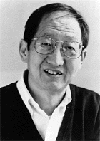|
GOLDSEA | ASIAMS.NET | ASIAN AMERICAN PERSONALITIES THE MOST BRILLIANT ASIAN AMERICANS OF ALL TIMEPAGE 2 OF 2
Daniel Tsui shared the 1998 Nobel Prize in Physics for using powerful magnets and extremely low temperatures to show that thin sheets of electrons behave as a frictionless superfluid on a macro scale. This discovery of a quantum fluid with fractionally charged excitations is inspiring a new area of research that holds the promise of revolutionary technological applications. Tsui's achievements as an experimental physicist and a Princeton electrical engineering professor are all the more remarkable because he was born to illiterate peasants in rural Henan, China in 1939. Tsui began his academic career hoping to study medicine in Taiwan but was inspired to become a physicist by the Nobel Prize awarded in 1957 C N Yang and T D Lee.
Wang was a young Harvard researcher in 1948 when he devised a way to store data in an array of magnetic ferrite cores. Harvard had no interest in patents, and Wang probably didn't recognize that his discovery would enable the development of computing machines when he personally filed the patent application in September of 1949. On June 22, 1951 Wang began tapping the new technology's potential by founding Wang Laboratories in Boston with $600 in savings. “I founded Wang Laboratories to show that Chinese could excel at things other than running laundries and restaurants,” Wang once said. The company helped evolve a clumsy new technology into useful calculating machines and word processors, laying a foundation for the personal computing revolution. An important source of capital was the money IBM paid in 1955 for Wang's magnetic-core memory patent. An Wang was born February 2, 1920 in China and immigrated to the U.S. in 1945. He died in 1990.
Molecular biologist David Ho became a leader in the global fight against AIDS when he combined various protease inhibitors and antiviral drugs to devise a "cocktail" strategy to inhibit the replication of HIV. His approach initially offered a ray of hope to a scared world and he was named Time's Man of the Year for 1996. Ho was born November 3, 1952 in Taichung in southern Taiwan. He began studying physics at Caltech but became drawn to gene-splicing technology. Ho currently heads up research at the Aaron Diamond AIDS Research Center. CONTINUED BELOW
During World War II the U.S. Army made use of young I M Pei's MIT architecture degree and knowledge of Asian architecture by directing him to devise the most efficient ways of burning down Japanese cities. In the half century after the War, Pei designed over 50 daringly geometric buildings found in most of the world's great cities, including the East Wing of the National Gallery, Boston's JFK Library, the Louvre pyramid and Hong Kong's Bank of China tower. I M Pei was born in 1917 in Guangdong Province, China and grew up in Shanghai. He came to the U.S. in 1935 to study at MIT. After the war he received a masters from Harvard on the G.I. Bill. He founded the now venerable firm of I M Pei and Partners in 1955.
Michiko Kakutani has become an urban legend by exhibiting fearsome integrity in sniffing out literary high, low and false notes for the world's most influential book journal while somehow preserving the personal profile of a zen monk. Her work as head critic of The New York Times Review of Books won her the Pulitzer Prize for Criticism in 1998, which includes a $5,000 honorarium. Kakutani was born on January 9, 1955 in New Haven, Connecticut and received a B.A. in English from Yale in 1976. She worked briefly as a reporter at The Washington Post, then as a Timestaff writer before joining the Times in 1979 to report on cultural news. She shifted to reviewing books in 1983. Kakutani is single and lives in Manhattan.
Ming Chin's 1996 appointment to the seven-seat California Supreme Court marked an almost inevitable milestone in a pioneering legal career. Chin had distinguished himself as a capable business litigation trial lawyer at a time when few Asian Americans had begun entering the legal profession. That led to his appointment to the Alameda County Superior Court. In November of 1994 he was elected to a 12-year-term as Presiding Justice of the First District Court of Appeals, Division Three, positioning him to be tapped to the state's highest court by Governor Pete Wilson. Ming Chin was born August 31, 1942 in Klamath Falls, Oregon. He received his law degree in 1967 from the University of San Francisco's Hastings School of Law and passed the bar in 1970 after a two-year stint as an Army officer, including a year in Vietnam. His first job as a lawyer was prosecuting felonies and misdemeanors with the Alameda County D.A.'s office. Chin is a recognized authority on the use of DNA evidence. |
CONTACT US
|
ADVERTISING INFO
|
||||||||||||||||||||||

 7. Daniel C. Tsui
7. Daniel C. Tsui
 8. An Wang
8. An Wang
 9. David Ho
9. David Ho
 10. Ieoh Ming Pei
10. Ieoh Ming Pei
 11. Michiko Kakutani
11. Michiko Kakutani
 12. Ming W. Chin
12. Ming W. Chin





